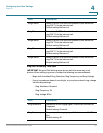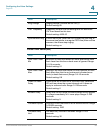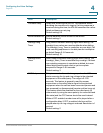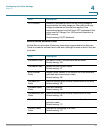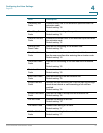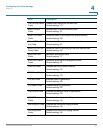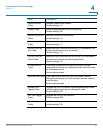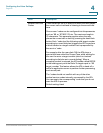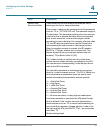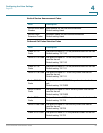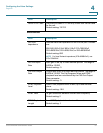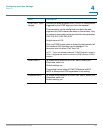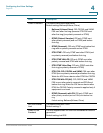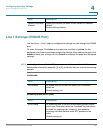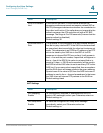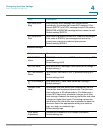
Configuring the Voice Settings
Regional
Cisco SPA232D Administration Guide 95
4
Feature Dial
Services Codes
These codes tell the ATA what to do when the user is
listening to the first or second dial tone.
One or more *codes can be configured into this parameter,
such as *72, or *72|*74|*67|*82, etc. The maximum length is
79 characters. This parameter applies when the user has
a dial tone (first or second dial tone) After receiving dial
tone, a user enters the *code and the target number
according to current dial plan. For example, after user dials
*72, the ATA plays a special tone called a Prompt tone
while awaiting the user to enter a valid target number.
When a complete number is entered, the ATA sends a
INVITE to *72 target_number as in a normal call. This
feature allows the proxy to process features like call
forward (*72) or Block Caller ID (*67)
The *codes should not conflict with any of the other
vertical service codes internally processed by the ATA.
You can remove a corresponding *code that you do not
want to the ATA to process.
You can add a parameter to indicate which tone plays
after the *code is entered, such as *72‘c‘|*67‘p‘. Below is a
list of allowed tone parameters (note the use of open
quotes surrounding the parameter, without spaces)
‘c‘ = <Cfwd Dial Tone>
‘d‘ = <Dial Tone>
‘m‘ = <MWI Dial Tone>
‘o‘ = <Outside Dial Tone>
‘p‘ = <Prompt Dial Tone>
‘s‘ = <Second Dial Tone>
‘x‘ = No tones are place, x is any digit not used above
If no tone parameter is specified, the ATA plays Prompt
tone by default. If the *code is not to be followed by a
phone number, such as *73 to cancel call forwarding, do
not include this parameter. Instead, add the *code in the
dial plan and the ATA send INVITE *73@..... as usual when
user dials *73.
Default setting: blank
Field Description



